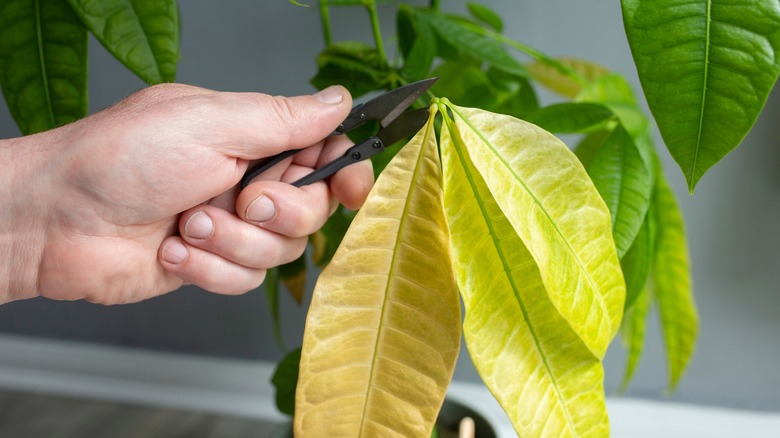Here's What Your Money Tree's Yellow Leaves Really Mean (& How To Fix It)
If tropical houseplants had magic powers, everyone would pick up the "money tree," a.k.a Pachira aquatica, for a little wallet boost. Sadly, there is no evidence that its braided stems and five-lobed leaves, stretched like an open palm, actually bring in money. But it can't hurt to hope, right? Regardless of what's in its pockets, it's hard watching your money tree's leaves turn a sickening yellow before dropping to the floor.
The good news is that yellow leaves are typically a sign of overwatering. It's tempting to give them more water than you likely drink in a day, but unlike the trendy self-watering plants that take care of themselves, too much can prove fatal. Sitting in soaked soil can cause root rot for money trees that prefer to be potted with the same well-draining soil as cacti. Then, when the soil is between half and three-quarters of the way dry from its last watering, you should pour water into the pot from the top and wait for it to come out of the bottom drainage hole. You can avoid making a mess while watering your houseplants with the right tools, like a saucer.
While fractions make watering sound precise, it doesn't have to be stressful. Just stick your finger a couple of inches down into the soil to see if it feels mostly dry. If it feels wet, don't water, but also don't wait until the soil is so dry that it pulls away from the sides of the pot, forming an impenetrable clump.
Other potential indicators of trouble in money plants
While overwatering is the most likely cause of yellowing leaves in your money tree, there is the possibility of light and age being a factor as well. Pachira aquatica is a tropical plant, but its leaves are sensitive to intense, direct sunlight. They prefer a sunny room: plenty of light but not directly against the window. The way to tell if your tree is getting too much or too little light is to pay attention to how the leaves change color. Leaf burn from too much light will crisp and brown the edges, or they may look spotty. Low light will cause the plant to lose leaves that will look the same pale yellow. Moving to save the plant from too much light is important, but money trees can usually adjust to lower light environments in time.
Outside of yellowing, brown, white, or curling leaves are also symptoms you may come across as you learn how to grow and care for a money tree. Brown leaves can be a sign of root rot, which comes from overwatering. Meanwhile, white leaves are often a sign of fungi or powdery mildew and should be handled as soon as possible. If your leaves are speckled and curling, you could be looking at underwatering or spider mites. Despite these possible concerns, money trees will naturally lose leaves as they create new ones; they are still generally low-maintenance and make amazing houseplants!

